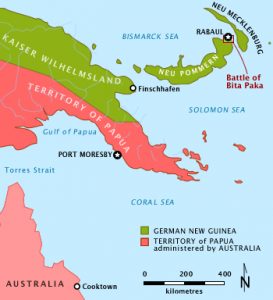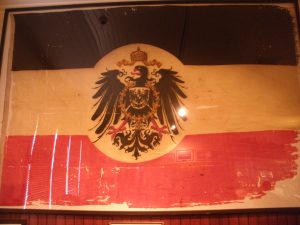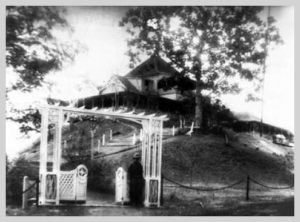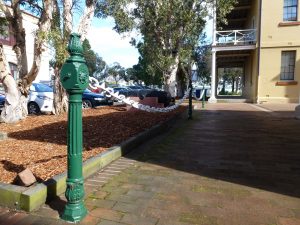- Author
- A.N. Other
- Subjects
- History - general, Ship histories and stories, History - WW1, History - WW2
- Tags
-
- RAN Ships
- None noted.
- Publication
- September 2014 edition of the Naval Historical Review (all rights reserved)
This continues our voyage to Papua New Guinea in MV Pacific Dawn, with the March 2014 edition of the NHR, detailing experiences encountered at Milne Bay. Further information on Rabaul during the attack and occupation by the Australian Naval & Military Force is also to be found in the March 2014 edition of this magazine.
Early History
The celebrated explorer William Dampier is credited with the discovery and naming of Nova-Britannia (New Britain) in 1700. The beautiful expanse of Blanche Bay, the upper reaches of which are known as Simpson Harbour, was surveyed by Captain Cortland Simpson, RN in HMS Blanche in 1872. Fearing a race for unclaimed territory near its northern borders in 1883 the Queensland colonial government attempted to annex the southern portion of New Guinea, known as Papua. This led the British and German governments to take action and in 1885 they reached agreement regarding their respective boundaries in New Guinea, with the northern portion becoming part of the new German colony called Kaiser-Wilhelmsland, with New Britain becoming Neu-Pommern and New Ireland named Neu-Mecklenburg. The southern portion (Papua) came under British jurisdiction.
A German Colony
German missionaries landed near the village of Matupi on the shores of Simpsonhafen (Simpson Harbour) on 29 September 1882 and the first church was established there. The settlement grew when a trading post with a small German community began in 1887. The beginnings of Rabaul on the north coast of Neu Pommern can be traced back to 1902 when planning commenced to relocate the capital of the German colony. Herbertshohe (now Kokopo) was handi-capped by the lack of a safe anchorage. Accordingly Rabaul, in the local language meaning ‘the mangroves’, was claimed and the mosquito infested swamps at the head of Simpsonhafen were drained. This was a fine example of engineering technology but the choice of site remained questionable as it was in the basin of an ancient caldera vulnerable to eruptions from continuing volcanic activity.
While the native population knew of prior volcanic eruptions they could not be specific about dates, but Europeans recorded a large eruption in 1878. However the new garden city was planned to exacting specifications with wide tree lined avenues of whitewashed bungalows. In 1910 the Governor, Dr Albert Hahl, moved into a well-proportioned Government House on Namanula Hill which enjoyed spectacular views overlooking the newly found township with its fine harbour, which by this time boasted botanical gardens, a hospital, recreational clubs and a cinema. The new capital flourished and was beautifully groomed with an abundance of well tended and colourful tropical foliage. This perfection was shattered in September 1914 with the arrival of the Australian Naval & Military Expeditionary Force (AN&MEF) which, after a brief engagement with the limited defending forces, gained control of the German colony with minimum loss of life, other than for the tragic loss of the submarine AE1 and her crew.

Bita Paka Mysteries
Memorials to many of those who lost their lives at Rabaul during both world wars are to be found at a small but well tended Australian War Graves cemetery at Bita Paka. This was well chosen, given that it was the site of an important German radio station which gave rise to the early Australian entry into WW I.
Following a landing on 11 September 1914 by armed units of the AN&MEF they came in contact with German colonial forces, resulting in a number of casualties. There is an early photograph taken in about 1916 showing four graves at Herbertshohe. These included Able Seaman W.G.V. Williams and Captain B.G.A. Pockley of the Australian Army Medical Corps who were removed to the ship HMAT Berrima where both died of wounds later the same day. Another grave is of Able Seaman H.W. Street who was at first buried near where he was killed on 11 September, but later reinterred at Herbertshohe. The final grave is of Able Seaman H.C. Willans who died on active service on 24 December 1914.
Owing to the odd spelling of the name Willans and his death long after hostilities had ceased, further inquiries were made. Herbert Charles Willans was born in Cardiff, Wales on 27 May 1888 and entered the Royal Navy as a Boy Seaman on 31 October 1904, his previous occupation being errand boy. He was only to serve in training ships for just over three months and was then invalided and discharged from service. Considerable detective work was undertaken to find further reference to Willians as he appears to have slipped through the official records. He was an early entry into the Great War, enlisted as an Able Seaman RANR on 14 August 1914 with the Official Number 369, by E. Argent at Largs. LCDR Edwin Argent was Assistant to the District Naval Officer, Largs Naval Depot, Adelaide – he had been Chief Gunner of HMCS Protector during the Boxer Rebellion. Willans later served in the captured German prize Komet, re-named HMAS Una. He died ashore at Herbertshohe on 24 December 1914 suffering from complications after contracting malaria. What is strange is that no record of him appears in the Australian National Archives or the AN&MEF Embarkation Rolls, although he is named in the Roll of Honour of war dead.
Those who died here were not left in peace for too long as they were first moved to another cemetery at Herbertshohe in 1915-1916 and again reinterred at the Rabaul Military Cemetery in 1919. In about 1950 when the Bita Paka War Cemetery was consecrated the bodies of these four men were transferred to Bita Paka.
Australian Occupation
In anticipation of an attack and in an attempt to avoid or delay capture, Governor Hahl had relocated his administration to the small settlement of Toma. These circumstances would be repeated by another regime some 27 years later. The long serving Governor Hahl, who had founded Rabaul in 1903, returned to Germany on 13 April 1914 and handed over the administration to Dr Eduard Haber who became Acting Governor. It was Haber who organised an armed resistance force based at Rabaul.
Government House was occupied by the Australian military administration, initially under Colonel William Holmes, until 1921 when it became the seat of the civilian administrator of the newly mandated territory of New Guinea. Despite these changes and the effects of world-wide economic depression the city continued to flourish. In May 1937 a series of earth tremors culminated in a volcanic eruption which caused widespread destruction covering Rabaul in ash and mud and over 500 people perished. While most of the population was moved temporarily to Kokopo they gradually returned to Rabaul. It was however decided to relocate the capital to Lae and this occurred at the outbreak of WW II in September 1939 when the Administrator, Brigadier Sir Walter (Ramsay) McNicoll, moved his headquarters to Lae, leaving his assistant Major Harold Page, DSO, MC, in change at Rabaul.

Following the outbreak of WW II Rabaul was garrisoned by about 1,400 troops known as Lark Force. The Japanese first carried out light bombing of Rabaul in early January 1941 and on 18 January a local aircraft spotted a Japanese fleet off the tip of New Ireland a few hundred miles north; this gave rise to a move of civilians away from the city. On 20 January at least 80 bombers and 40 fighter aircraft attacked and crippled the small Australian air defence of 11 aircraft; two days later 70 more aircraft attacked, dropping 500 lb bombs which eliminated all anti-aircraft and other defensive gun positions. When the Japanese landed with over 5,000 troops on 23 January only token resistance was possible and within a few days the island was in Japanese hands, becoming a centre of Japanese activity in the western Pacific. In June 1942 over 1,000 military and civilian prisoners of war (which included Major Page, together with many from Lark Force) were to perish in the tragic sinking of the Montevideo Maru when the Japanese decided to relocate prisoners from Rabaul to Hainan.

With Japan losing the air war in the Pacific the US Air Army Force commenced bombing Rabaul in early 1943 and continued until the Japanese forces of over 100,000 troops surrendered in 1945 at the war’s end. By mid 1944 the once picturesque and flourishing garden city was a mass of rubble with Government House on Namanula Hill being obliterated in one raid; all that now remains of this magnificent building are two gate posts. Photographs of Government House taken in 1927 have been discovered showing the posts (stanchions) and associated chains in their original positions.
Links Cast In Iron
At some stage a few Jack Tars must have liberated some of the fine suspended chains which marked the boundary of Government House. Years later a sample of these made their way to Garden Island where in the 1930s they provided a fence around the figurehead from HMS Sealark which was then sited at the northern end of the island, close to the ferry wharf. They were then removed and lay forgotten until rediscovered in the late 1950s by founding members of the Naval Historical Society, the late Lew Lind and the very alive Norm Rivett. Both Lew and Norm thought these had been acquired from Rabaul at the end of WW I as a German 12 pounder field gun manufactured by Krupp in 1892 was brought to Garden Island by a returning HMA Ship at the end of hostilities and now resides in the Naval Historical Centre. The remains of the Germanic chain fence can now be seen between the historic Barrack Building and the Garden Island Chapel.

Volcanos
Just as Rabaul was beginning to fully recover from the devastation it had suffered during the 1937 earthquake and then the bombing and devastation following the Japanese occupation, another enormous earthquake hit the city in 1994. Over 80% of buildings were destroyed by falling volcanic ash; luckily with sufficient warning there was minimal loss of life. After this eruption the provincial capital was again moved to Kokopo. However the locals love the old town and they are gradually returning to Rabaul.
One day in Rabaul is insufficient to see all it has to offer as it again rebuilds itself from the ashes. Not only is this a beautiful setting with hospitable and resilient people but there are many historic sites including many caves used as air-raid shelters, and a small museum worthy of exploration. For the more adventurous there is also much to be found below the clear waters of the harbour, containing the wrecks of more than 50 Japanese ships. To those with some knowledge of our place in Pacific history, walking amongst these dusty sites is a worthy and rewarding experience, possibly just as important as walking along the far more distant shores of the Aegean Sea.




